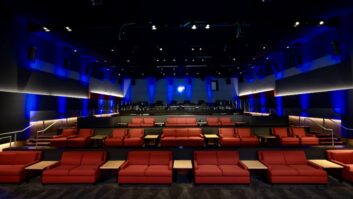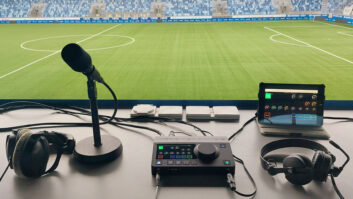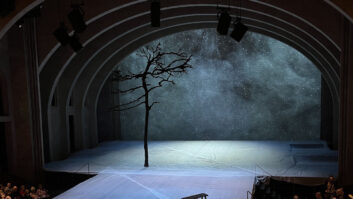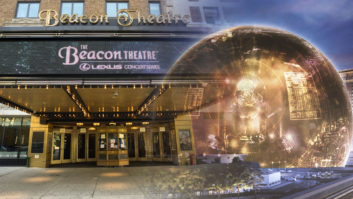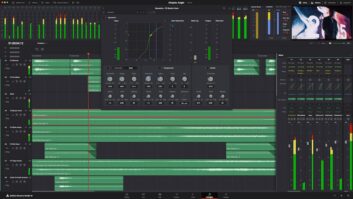After a 17-year break, the four original members of the legendary Firesign Theatre comedy troupe returned to the recording studio last year. Their mission: to record a new, original comedy album-Give Me Immortality or Give Me Death-released last fall by Rhino Records. Since the group had not put out an original album since 1982, and since most of its classic recordings were created between 1967 and 1971, one might presume a touch of audio culture shock washed over Phil Austin, Peter Bergman, David Ossman and Phil Proctor-now in their late 50s and early 60s-when they first entered Sunburst Studios in Culver City to record Immortality under the guidance of veteran engineer Bob Wayne. However, “It’s not like we spent the last 17 years in a time warp,” says Austin. “We’ve been working individually in the audio business all this time, doing commercial, TV and film work. We’re all well aware of the wonders of modern technology.”
That point is immediately obvious in the album’s creative direction, which adopts a media-based format (radio) and twists current themes into typical Firesign comedy. It’s a style Bergman defines as “similar to a jazz-like radio play,” along the lines of classic Firesign records made for Columbia, including Don’t Crush That Dwarf, Hand Me the Pliers (1970) and I Think We’re All Bozos on This Bus (1971). This time, the group offers a radio broadcast that examines the looming millennium by counting down the last few hours of the “old” century on New Year’s Eve, 1999. The broadcast airs on a ’90s-style, monolithic radio service, dubbed Radio Now, which changes formats every few minutes. During the course of the broadcast, listeners are treated to bizarre traffic reports, news, sports and “celebrity stalking,” all orchestrated by DJ Bebop Loco (played by Austin). Their coverage of events like the sinister schemes of mysterious men in eyeball hats, advertising icon Joe Camel’s tragic fall from grace, the “death” of a doll named Princess Goddess and the unexpected consequences of the year 2000 computer crash, make up an album so unorthodox that it presented numerous recording challenges during its creation.
“In the broadest sense, it was the same process [we used in the ’70s], in that we decided to record the album in order, end-to-end, after a couple of months writing a basic script,” says Proctor. “That script, of course, changed dramatically during the sessions, and as usual, we went into the studio with absolutely no idea how the piece would end. That’s probably the area where newer technology helped the most: We brought a laptop computer and a printer into the studio, and for the first time in our careers, we wrote, re-wrote and updated the script as we went along, in the studio. That little PC actually helped us organize the project much more efficiently than we used to.”
The album’s 29 connected scenes were recorded in order through a Trident board and Neve preamps onto 32 tracks of Alesis ADAT-XT, and mixed to a Panasonic 3700 DAT. The plan to record the CD in linear fashion meant engineer Wayne had his hands full, especially since the project required extensive, live Foley work and other “madness,” to use Ossman’s term.
“All of us in Firesign Theatre are used to Phil Proctor ripping apart studios,” says Austin. “But Bob Wayne had never worked with us before. I remember one point when Bob and I were in the control room together and we heard a loud rumbling above us. Bob thought it was an earthquake. But I told him, ‘That’s just Phil Proctor upstairs looking for cardboard boxes for Foley.’ Bob told me that the ceiling was not secure and no one was allowed up there. He was real worried that Proctor would fall through it and between the two pieces of glass in the recording booth. We decided if Phil fell to his death between the pieces of glass, we would use a picture of his body wedged in there as the album’s cover.”
Proctor and Wayne survived the experience, and others, as Proctor went through trash dumpsters, empty rooms and cabinets in search of Foley material that he and his mates promptly dumped onto the floor in the middle of Wayne’s studio, thereby creating an instant Foley pit. It was worth the trouble, since the four members of the group performed most of the Foley work themselves, in real time during recording.
Austin says the four men purposely tested Wayne’s patience early on because “at our age, we aren’t about to change our way of writing and performing our material. We’ve been known to be a real pain in the ass for recording engineers. As it turned out, Bob was a genius and he greatly helped this record. We made him fight his way in and force us to stop and protect material, and he ended up influencing us greatly.”
One of Wayne’s many challenges was how to allow the Firesigners to seamlessly transition their “big studio” mentality into his Sunburst facility, which is much smaller than the huge studios the group used in its Columbia days.
“We’re used to gigantic studios,” says Ossman. “At Columbia [Studio B in L.A], we would just tear the studio apart, running mics and wires everywhere we wanted and taking advantage of all the Golden Age radio mics and sound effects tools they had lying around. Sunburst is much smaller, which ended up being important for the sound of the album, since almost all of it takes place inside a small, enclosed radio station. But we still wanted to work the same way that we always had.”
Wayne also had to figure out how to mike everyone properly for the numerous voice effects and characters that appear on the album, while allowing them the physical freedom to perform and interact in real time. “I had to set them up so they could see and hear each other, along with the sound and musical effects, and let them do each piece and move onto the next one,” says Wayne. “I had never really worked on an album in this manner, recording as one continuous piece. The guys really wanted to hear the realism of each piece, rather than adding things later in post.”
Capturing that realism often meant choosing microphones that matched the creative content of the scenes. In Bergman’s scenes as sportscaster Chump Threads, for instance, Chump reads sports from an old radio booth. So Wayne put Bergman in a vocal booth and set him up with an old RCA-44, a square ribbon announcer’s microphone from the 1940s. Bebop Loco, on the other hand, is more of a hip, modern disc jockey, so Wayne placed Austin on the other side of the studio, behind a rolling baffle, and had him use a contemporary AKG 414 condenser mic. Ossman and Proctor, meanwhile, portrayed the station’s two confused newscasters, Harold Hiphugger and Ray Hamberger (pronounced Hambur-ghe), two return characters from 1974’s Everything You Know Is Wrong. Ossman (as Hiphugger) used a Neumann U87 vocal mic behind a baffle, while Proctor (as Hamberger) set up in the studio’s drum booth so that he could also perform in conjunction with some complicated effects as traffic reporter, Captain Happy Pandit. He used an EV RE-20 radio mic for his news announcing scenes.
But each man played multiple parts and contributed to the album’s Foley and effects work, and some of that work was “improvised in the grandest Firesign tradition, with a lot of help from Bob Wayne,” says Proctor. His work as Happy Pandit in the helicopter circling fictional Fun-Fun Town, where the album takes place, is a prime example. The group needed Captain Happy to sound as though he was on a helicopter, speaking over a wireless headset, so they had to improvise a method to create that effect.
“Again, they wanted the reality thing, so we couldn’t add helicopter sounds later; we had to have them running while Phil was talking,” Wayne explains. “We recorded him in the drum booth, and I gave him one of those tiny, round crystal microphones, the kind with a little clip on the back. It cost maybe two dollars and doesn’t even have a brand name on it. I had Phil use that, and then I heavily compressed it to make it sound more like a wireless headset mic. It was a very tinny sound, but that is what we wanted. Then, we decided not to use canned helicopter sounds because Phil had to sound like he was actually inside the helicopter, not outside of it. I recorded a car chase on TV, put that on cassette, edited it to get ten to 20 seconds of the copter sound when the announcer was not speaking, and then I put it inside a sampler and put the sound into a cyclical pattern. As Phil read his lines, I played that sound, and then we laid the whole thing onto tape.”
When Ossman did his bits as “celebrity stalker” Danny Vanilla-who gets a little too close to the object of his desire, Princess Goddess-Wayne stationed him outside the studio, in the parking lot, and ran wires to a hand-held, Shure SM57 microphone.
“That allowed us to pick up car and crowd noises in the background, which is what the scene required, and gave the impression Danny was filing a location report,” Wayne explains. “We also got a break when it started to rain. We let the microphone pick up ambient sounds of rain hitting his umbrella, and that gave the scene more realism.”
Such techniques were routine throughout the recording sessions. But since the album takes the form of a radio broadcast, significant use of music was also required. “In the past, we mainly used live musicians in studio,” says Austin. “But this time, we bought cuts from the APM music library. The truth is, the music quality is so high these days, played by the best people in L.A., London or New York, that we had plenty to choose from to create musical IDs and commercial music for this album. It gave us a wider range of choices than if we had done it the way we used to. I’m sure such musical libraries will be our tool of choice on future albums.”
And there will be future Firesign albums, thanks to solid sales for Immortality. The group is already writing and expects to begin recording a new album, tentatively titled You Just Don’t Get It, Do You?, in the next few months, probably for release at the end of the year. Despite some of the arduous work involved to get Immortality just right, Wayne hopes to engineer that one, as well.
“I learned a lot working with these guys,” Wayne says. “Even when they weren’t sure how the album would end, and were improvising like crazy, they rarely required more than three takes for anything. That’s really rare, especially when almost everything was done in order, with all four guys live on mic, performing multiple characters and effects. It was essentially a continuous performance, and that is something you don’t see too often. Plus, it was a lot of fun, with the four of them running around, wearing those strange eyeball hats.”
